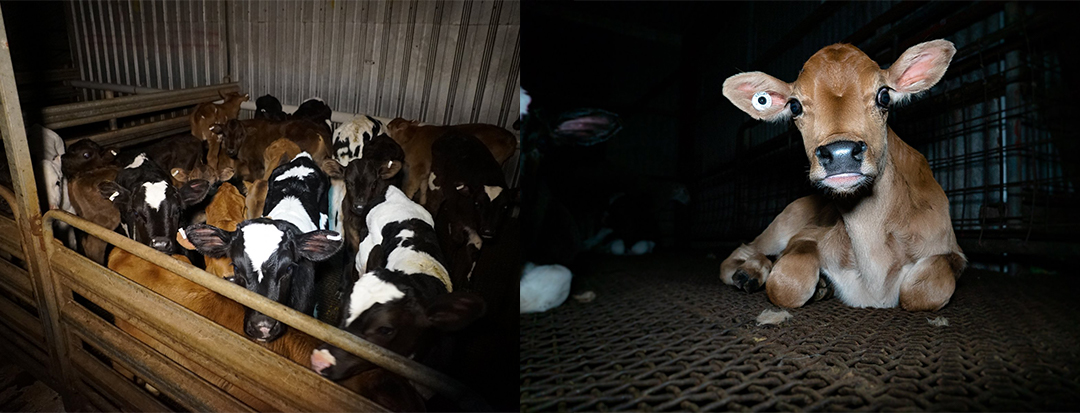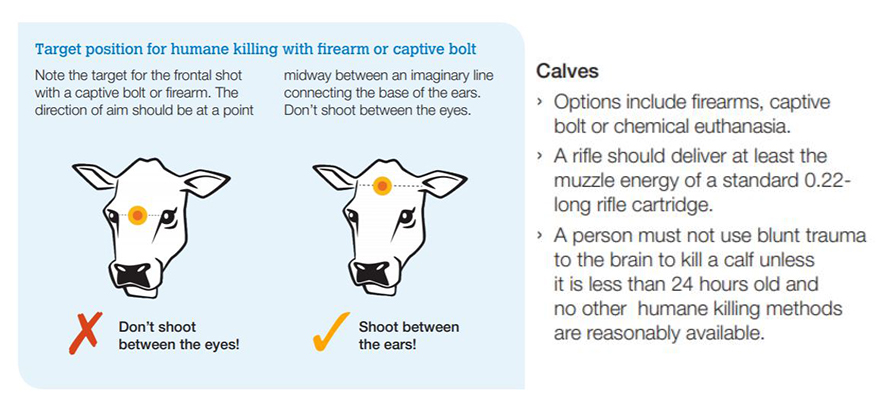Calves
Calves
Birth
Like humans, dairy cows carry their young for nine months before giving birth. Historically, most calves would be born in spring, during the months of September, October and November. These days, large dairy farms generally have two calving seasons, one in Spring and one in Autumn (March, April, June). Calving can start as early as January or February on some dairy farms, and cows are generally pregnant for 10 months of the year, with two months 'off.'
Some dairy farms will induce labour in pregnant cows as a way of coordinating the birth of calves and, therefore, the availability of milk from their mothers. This risky practice has a high chance of leading to stillborn or premature calves and to infection in their mothers. Calves that are born too weak are often killed via a blow to their skull.
A farmer using a metal contraption to assist a cow to give birth on a South Australian Dairy Farm (Source: Westdama Dairy, 2023)
Separation
Calves are separated from their dam (mother) almost immediately - usually within 12 hours of birth. Research has shown this separation causes calves to become distressed, pessimistic and even depressed. There are also numerous reports of cows crying out for their calves for days to weeks on end after being separated from them. Cows are also known to chase after the vehicle taking their calves away, in a desperate attempt to stay with them. Footage captured by Farm Transparency Project in September, 2023, shows cows pursuing trailers with their calves, as well as newborn calves being dragged and roughly shoved by workers.
Some of the female calves are reared by farmers to eventually be 'replacements' in the milking herd, generally having their first insemination at 15 months old and birthing their first calf at 2 years old.
A 2019 investigation by Animal Liberation showed shocking conditions on an Australian dairy farm. Watch the video here: https://youtu.be/XIiYju3Y3fA
Slaughter
The term 'bobby calf' refers to a newborn calf who is less than 30 days old.
Male bobby calves, unable to ever produce milk, are largely considered waste products of the dairy industry. Aside from a small number kept and used for breeding, the majority are killed within the first week of their lives due to their lack of usefulness to the industry.
One third of female bobby calves born into the dairy industry will also be slaughtered as they are not required for replacement in the 'milking herd'. Male calves who are not killed at birth are usually raised and sold as veal (under 12 months) or 'dairy beef' (12-18 months).

Bobby calves in an Australian slaughterhouse holding pen.

A bobby calf in a holding pen at Tasmanian Quality Meats Slaughterhouse (Farm Transparency Project, 2024)
A 2023 investigation by Farm Transparency Project showed dozens of week old calves killed while fully conscious at Tasmania's largest calf slaughterhouse.
In the 2022-2023 financial year, Dairy Australia reported that over 300,000 bobby calves were sent to the slaughterhouse, however this figure does not include bobby calves that are slaughtered on-farm, or those raised and sold as beef. The RSPCA says that each year, at least 400,000 bobby calves are destined for slaughter.
Calves can be killed on a farm by blunt-force trauma, within their first 24 hours of life. Other methods include the use of firearms, captive bolt gun or chemical euthanasia.

Humane killing and disposal of sick or injured cattle. Source: Dairy Australia
If calves have not been killed on farm within their first 5 days of life, they are often taken to livestock sales to be sold to abattoirs. The hides are pulled from their slaughtered bodies to be turned into leather, while rennet for cheese making is extracted from their stomachs, and their by-products and blood are sometimes used by the pharmaceutical industry. A small number of bobby calves are grown out for longer, up to 20 weeks, to be slaughtered for veal.
There have been several campaigns exposing the cruel treatment of bobby calves in the Australian dairy industry during their transport, sale and slaughter.
End Dairy Slaughter - Farm Transparency Project (2024)
Dairy is Scary - Animal Liberation (2019)


